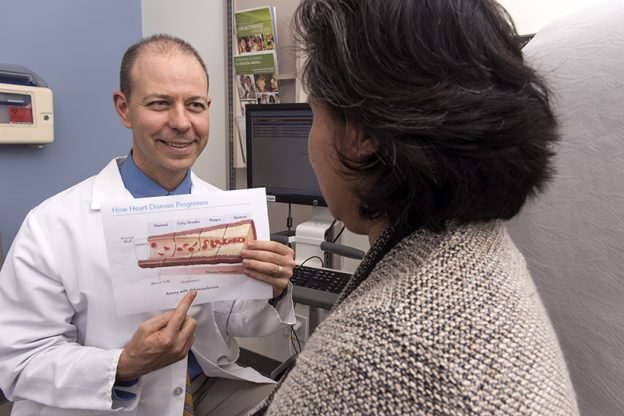
Use of cholesterol-lowering medications increasing
At A Glance
- Study documented use of cholesterol-lowering statins before and after new guidelines were released in 2013.
- Statin use increased among patients at risk of cardiovascular disease, and others who could benefit.
According to a study published in the journal Cardiovascular Drugs and Therapy, use of cholesterol-lowering statins increased within Kaiser Permanente Southern California after new treatment guidelines called for broader use of the medication to treat and prevent cardiovascular disease.
The study documented trends in the use of statin medications and statin dosages at Kaiser Permanente Southern California before and after publication of the 2013 treatment guidelines. More than 2 million people were included in the study from 2009 to 2015.
“We found statin use increased substantially among patients at risk of atherosclerotic cardiovascular disease and use of appropriate statin dosages increased for many patients who could benefit from the medication,” said Teresa N. Harrison, SM, a senior research project manager with the Department of Research & Evaluation and the lead author of the article. “We also found that some patients who could benefit from statins may not be getting them, suggesting that we have an opportunity to improve physician’s knowledge and awareness of the new treatment guidelines.”
New guideline expanded number of people treated with statins
In 2013, the American College of Cardiology and the American Heart Association released a new guideline on the treatment of high blood cholesterol to reduce the development of cardiovascular disease.
Previous guidelines had recommended treating people who have high cholesterol, but the new guideline expanded treatment to all adults with atherosclerotic cardiovascular disease (ASCVD), regardless of cholesterol levels. The guideline also recommended statin treatment for people with high cholesterol (LDL-C levels of 190 mg/dL or higher), for people with diabetes ages 40 to 75 years, for people with a 10-year ASCVD risk of 7.5% or more. It also recommended higher-intensity statins for some patients.
“Statins benefit people across a range of cholesterol levels if their risk for cardiovascular disease is high,” explained Ronald Scott, MD, the cardiovascular co-lead for Southern California Permanente Medical Group and a co-author on the research. “Statins lower people’s risk of heart attack and stroke. So, if you give it to the people at highest risk of heart attack and stroke, you can drive down the heart attack and stroke rates in the whole population.”
Among the patients ages 21 years and older at KPSC:
- 5% had atherosclerotic cardiovascular disease or ASCVD
- 1% had high LDL-cholesterol (LDL-C 190 mg/dL or higher)
- 6% had diabetes, and
- 10% had a 10-year ASCVD risk of 7.5% or more.
Research findings were generally positive
“The study’s findings show that physicians at Kaiser Permanente have been working effectively to improve statin utilization”, said Kristi Reynolds, PhD, MPH, the director of Epidemiologic Research at the Department of Research & Evaluation and senior author of the research.
“In general, we found that rates of statin use were either stable, or increasing,” Dr. Reynolds said. “This shows that the education efforts that Kaiser Permanente has engaged in before and since the 2013 guidelines were announced have been successful in reaching many clinicians.”
Researchers found that:
- Statin use increased for people with a 10-year ASCVD risk of 7.5% or more from 36% to 47%.
- Use of statins was stable over time for adults with ASCVD, high LDL-cholesterol, and diabetes.
- High-intensity statin use increased 142% and 54% among patients with high LDL-cholesterol and those with ASCVD, respectively.
- Moderate-to-high-intensity statin use increased more than 50% among those with a 10-year ASCVD of 7.5% or higher.
The study also found variation in patient characteristics between statin users and non-users. In each of the groups of patients who could benefit from the cholesterol-lowering drugs, statin users had more physician visits and more health conditions. Fewer African-American patients with ASCVD were statin users across the study years, while the treatment rate increased among patients who were Hispanic.
Study also found room for improvement
Dr. Scott noted that Kaiser Permanente had been working to improve statin utilization before the guidelines were announced, but “we implemented the guidelines in Kaiser Permanente to continue the trend of cardiovascular event reduction, utilizing statins as a tool in that endeavor.”
Although there were substantial increases in appropriate statin use from 2009 to 2015, there is room for improvement, researchers said:
- 56% of patients with ASCVD, 67% of patients with diabetes and a 10-year ASCVD risk were not being treated according to guidelines potentially due to lack of provider knowledge.
- A low proportion of patients received a high-intensity statin despite a high lifetime risk of having a heart attack or stroke.
“We know Kaiser Permanente is on the leading edge of encouraging statin use among its members who could benefit from them, but still about 135,000 eligible patients were not receiving statins in 2015,” said Dr. Scott. “This research is the first step toward getting those people onto statins, too.”
He added, “We will be increasing our education efforts to make sure all physicians are aware of the importance of treating patients with statins, as well as continuing to provide them with tools and scripts to help them talk to their patients about taking these important medications.”





